The last two posts have involved rather a lot of me getting things wrong in a more or less embarrassing fashion, including about stuff I’ve either taught or written about. Obviously the thing to do next is to start giving opinions about a text written in a language I don’t even read, right? In fact, that might even be safer since at least here I know roughly how much I don’t know… But I have been meaning to write about this since the run-up to the Leeds International Medieval Congress last year, and my current somewhat shaky form isn’t going to stop me. So I want to introduce you to the work known as De Administrando Imperio by Emperor Constantine VII (913-959).1

Ivory depiction of Constantine VII being crowned by Christ, now in the Pushkin Museum, Moscow, image from Wikimedia Commons
You see, last academic year I was under a certain amount of social pressure to identify as a Byzantinist, what with the second-best Byzantine coin collection in the world (so it has been claimed) in my charge. I was also trying to get people to participate in a grand effort of comparison of medieval frontiers, and needed to come up with something for a Leeds session on that subject. And so I thought that it would be potentially interesting to compare what my speciality medieval magnate, Count Borrell II of Barcelona (945-993), did with his frontiers to what a completely different but roughly contemporary polity, which given my immediate circumstances should most obviously be the Byzantine Empire, did with some of its. And having declared such an intent, the obvious next step was the De Administrando Imperio.
Now, there are lots of things about this text that struck me and I want to write about at least a couple, without anticipating the actual paper too much since I have every hope that a version of it will some day go into print.2 But to say anything useful about what the De Administrando says it seemed more and more to me that the first step was to understand what it is, which should be simple but isn’t. What it immediately appears to be is a manual of statecraft by a Byzantine Emperor, written for his son and future successor Romanus II (959-963). In fact, firstly not very much of it is explicitly about the administration of the Empire and secondly quite a lot of it is not by Constantine VII.3 I’ll try and explain…
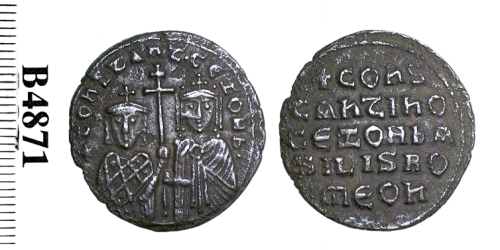
Bronze follis of Emperor Constantine VII with Empress Zoe, struck at Constantinople in 913-919, Barber Institute of Fine Arts B4871; Constantine is the little one on the left
In the first place one has to understand Constantine’s own life situation.4 He was son of the successful Emperor Leo VI the Wise (886-912) but was only two when Leo died, so although he succeeded he did so alongside his uncle Alexander (912-913), who kept his nephew mostly excluded from power during his short reign. Once Alexander was dead Constantine’s mother Zoe became leader of a regent council, but was for one reason or another unable to hold onto that status and the admiral of the fleet, Romanus Lecapenus, more or less took power in 919, marrying his daughter Helena to Constantine in that year and then assuming co-emperorship in 920.

Pierced gold solidus of Emperor Romanus I, showing him being crowned by Christ, with his son-in-law Constantine VII and his son Christopher sharing a cross on the reverse. Struck in Constantinople between 919 and 931, though narrower guesses have been made; Barber Institute of Fine Arts B4841
Over Romanus I’s long and more or less successful reign (920-944) power was shuffled and reconfigured again and again, it seems, with his own sons Christopher, Stephen and Constantine becoming co-emperors alongside and indeed in front of Constantine VII, in terms of how they were presented in public display and on the coinage.5 Another of his sons, Theophylact, became Patriarch of Constantinople in 933, although far too young. Christopher, who seems to have been the intended heir, however died in 931, and after that Romanus seems to have accepted that his other sons would not be able to keep Constantine VII from power, and returned him to a more obvious rôle. Constantine was spared the bother of a contest, however, because in 944 Stephen and his imperial brother decided they’d waited long enough, kidnapped their father and deposed him and when they returned to Constantinople the people rose against them and demanded that Constantine VII take sole power. Usurper father and rebels sons all died as monks, although Stephen outlived both Constantine VII and Romanus II. It’s a messy story.
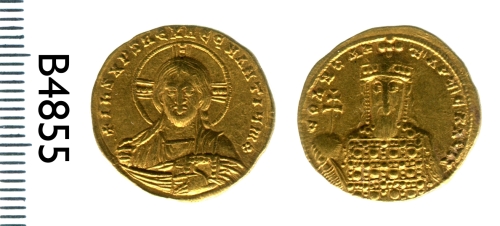
Gold solidus of Constantine VII struck in Constantinople, most likely between 945 and 959 but let’s be honest, could be earlier too; Barber Institute of Fine Arts B4855
What it all means for us, however, is that until 944 Constantine VII had a lot of time on his hands, and he seems to have spent a lot of this buried in books and the archives of the imperial palace. By the time he came to the throne he had a better idea than most about what the empire had been and some strong ideas about what it should now be, based not least on a series of treatises he had written, of which the De Administrando was only one.6 But he proceeded by compilation, pulling in materials of all vintages, so that the empire he reconstructed, and in the case of his book on imperial ceremony even enacted, was an empire that had never quite been, not all at once.
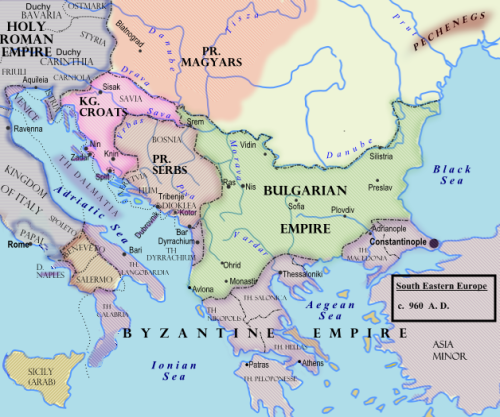
A modern map of part of the world as depicted by Constantine VII, by Hxseek at English Wikipedia – Transferred from en.wikipedia to Commons. https://commons.wikimedia.org/w/index.php?curid=6342264
This applies no less to the De Administrando, but this raises particular excitement for scholars of the areas that he covers. These are, more or less, the frontiers with non-Islamic powers: it starts with the Pechenegs and the various other peoples who can affect them, including Rus’, Bulgarians and Turks, then talks at length about the way the Rus’ get to Constantinople, briefly about how to constrain the the Khazars, then goes off for many chapters into a reprise of the early history of Islam, largely retold from the Chronographia of Theophanes, all of which seems to be leading up to the point at which the ‘Abbasids lost control of al-Andalus to the one Umayyad they’d failed to kill, ‘Abd al-Rahman I. But that, 756, is as far as that thread goes and then he moves onto recent diplomatic relations within Italy, a matter of much more current concern as Romanus was married to a daughter of King Hugh of Italy (924-947). After that he proceeds more or less geographically, giving a historical ethnography of the various Roman and Slavic peoples of the Balkans, moving into the Caucasus and then appending a series of anecdotes about treaties and the manning of the imperial fleet. He finishes with two legends from Cherson.

Bronze coin of Constantine VII struck at Cherson between 913 and 959, Barber Institute of Fine Arts B4918
From this you can see that if there was really an overall plan for this work, it was not adhered to very well. This has been explained by suggesting that Constantine had actually already nearly finished a different, more ethnographical work hypothetically known as the De Nationibus, and then before the final edit recycled its material willy-nilly into his new project for his son.7 But lots of that material is not only not his, but not reconciled at all with the other components of the work, which has suggested to many people that what we are getting here is nothing less than palace archival material copied without alteration, and often (it can be argued from the language used) based on or even actually being reports by local officials or informants from the areas concerned. This opens up for scholars of the early Slavs or the Rus’ the irresistible possibility that Constantine has preserved for them the earliest written records from their chosen peoples of study, and so there is great resistance to any suggestion that this is in fact a compilation of Constantinopolitan pseudo-history, selected by Constantine to justify baseless claims to imperial suzerainty of areas he couldn’t actually affect.8

Map of the rapids down the Dnieper river constructed more or less from the account of the De Administrando Imperio
And yet it sometimes seems as if it must be, because Constantine turns up so strongly as an authorial voice, which was the the thing that I liked best about reading the text. He starts the first chapter with a clear agenda:
“Hear now, my son, those things of which I think you should not be ignorant, and be wise that you may attain to government. For I maintain that while learning is a good thing for all the rest as well, who are subjects, yet it is especially so for you, who are bound to take thought for the safety of all, and to steer and to guide the laden ship of the world… I conceive, then, that it is always greatly to the advantage of the emperor of the Romans to be minded to keep the peace with the nation of the Pechenegs and to conclude conventions and treaties of friendship with them and to send every year to them from our side a diplomatic agent with presents befitting and suitable to that nation, and to take from their side sureties, that is, hostages and a diplomatic agent, who shall be collected together under charge of the competent minister in this city protected of God, and shall enjoy all imperial benefits and gifts suitable for the emperor to bestow.”
And he goes on with what is essentially a catalogue of people whom the Pechenegs can be induced to attack instead of the empire or who as allies of the empire may make the Pechenegs think twice before leaving their homeland open to attack by setting out against the empire. But it’s not long before that takes him onto ambassadorial routes to these people and then, apparently, he remembers this excellent account he has of bringing boats down the Dniepr from Kiev, and we’re off.9
Although a lot of the material can thus be explained as things it is useful for an emperor to know, some of it seems to have a bigger purpose, of presenting imperial claims in areas that lay well beyond the empire’s current control. On the former side there’s the intricate account of the recent politics of the Caucasus, important because almost all the rival potentates there had appealed for imperial support at some point and might do so again, always opening up opportunities for imperial expansion by force majeure. On the latter there are the quite dubious and much-debated claims about imperial Christianisation of the Balkans, which can be made into currently-relevant political statements but are at the least very odd ways to do that.10 Both of these cases are going to get their own posts, so I’ll not say more just now; instead, I’ll just add that not only do some sections, especially that on the Islamic conquest of Spain, not obviously serve any agenda beyond antiquarianism, but some are much more obviously personal. The little section on the imperial fleet—not the navy proper but a squadron maintained to carry the emperor and his officials in suitable style—is perhaps the most touching of these, where Constantine describes some of the men he remembers commanding the imperial galleys:
“When Podaron became vice-admiral, the protospatharius Theophylact Bimblidis was appointed protospatharius of the basin, who was nephew of the protospatharius John, surnamed Thalasson, and he lasted for a few years of the first reign of Constantine the Porphyrogenitus, the Christ-loving sovereign. On his death, since Michael the elder aforesaid [in a part not quoted here] was grown very old indeed and had given many long years of service as steersman, he was honoured with the rank of protospatharius and was also appointed protospatharius of the basin. And when the emperor embarked on the galley in the basin and set out either upon a progress or somewhere else, that good old man, ever memorable for his seamanship, would take his stand amidships of the galley, inspiring and urging the oarsmen of the galley to pull and row more bravely and manfully, and at the same time instructing the steersmen of the day how to manage the rudders and steer the imperial vessel when the winds were blowing distemperately. Well, he died….”11
I like this bit not just for the sheer irrelevance of Constantine’s genealogical detail—Romanus could surely get no benefit from knowing whose nephew an official of forty years before was—but because despite the third-person narrative, it’s clearly Constantine’s own memory we’ve got here, and it tells us that somewhere within the forty-five-year-old emperor who had spent much of his life as a virtual prisoner, albeit in a huge palace, was still the boy who had got to ride around on that galley and watch the elder Michael boss the sailors around in grand style.
Some of Constantine’s memories are less generous, and in particular, and understandably, he has almost nothing good to say of Romanus I Lecapenus. His words vary from lengthy accounts of why Romanus’s policy had been misguided, especially in areas where Constantine was now doing better, to straightforward character assassination:
“The lord Romanus the Emperor was an idiot and an illiterate man, neither bred in the high imperial manner, nor following Roman custom from the beginning, nor of imperial or noble descent, and therefore the more rude and authoritarian in doing most things … for his beliefs were uncouth, obstinate, ignorant of what is good, and unwilling to adhere to what is right and proper.12
One could certainly argue that this had a political purpose, since two of Romanus’s sons were still alive and, indeed, one Patriarch of Constantinople at the time of writing and might still have been seen as threats, and it’s an odd thing so thoroughly to insult your son’s grandfather in a work you’re giving to that son. This is not the only place where Constantine seems to have thought this work might have a wider audience, but on the other hand the contents could have been considered sensitive and the repeated addresses to his son make a specific audience also seem to have been intended.13
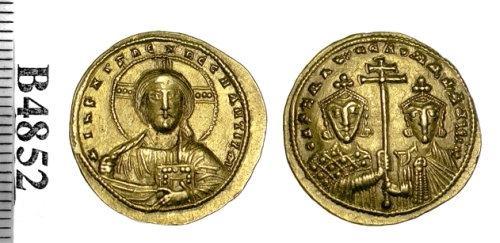
Gold solidus of Emperor Constantine VII with Romanus II, struck at Constantinople probably between 945 and 959, Barber Institute of Fine Arts B4852
One is left to wonder if Constantine really knew what he was doing with this work, or if it was even really finished; it seems not to have been edited, as said, its chapter headings don’t always match its contents and Constantine seems to refer here and there to things he’s failed to say in other sections.14 One explanation of the state of it might be that the single surviving manuscript, which was copied in the second half of the eleventh century, was made up from something that was still a working copy, with notes and materials laid in that were never supposed to be part of the final version. The scholarship is pretty clear that the text was finalised in 952, however, because that is a date actually given as current at one point in the text and was the year of Romanus II’s fourteenth birthday, when he might have been considered to have come of age, and the opening proem not only names the author, in the first person, and the recipient, but gives a summary of the contents that seems to match the order of what we have.15 In other words it looks as if this is something like what Constantine meant it to be, although if so one wonders if our copy was made from the final version, if Constantine had in fact read over that version or if he was really working at full power. Later sources suggest that Constantine drank too much wine, and there is something about the way this text proceeds that does remind me of one knowledgeable but ageing alcoholic I knew well in his declining years.16 But if the De Administrando is, in fact, just badly put together, what does that do to our attempts to divine its various deeper political and intellectual purposes? Maybe they have also to be assumed to be not very well put together. And can we trust such an author to have reported or copied his sources accurately? These are questions people probably don’t want to deal with, as they threaten to diminish how much we know, but what mainly strikes me all the same is how very human Constantine comes across in his attempt to compile his uniquely imperial wisdom.
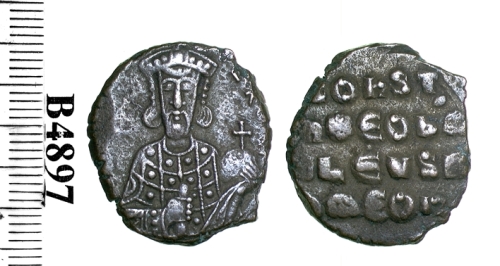
Copper-alloy follis of Constantine VII , struck at Constantinople probably between 944 and 959, Barber Institute of Fine Arts B4597
1. Constantine Porphyrogenitus, De Administrando Imperio, ed. Gyula Moravcsik, transl. Romilly J. H. Jenkins, 2nd edn., Dumbarton Oaks Texts 1 (Washington DC 1967), online here.
2. Though should you really care and need a citation, that would be J. Jarrett, “De Administrandis Marcis: the 10th-Century Frontier with Islam, seen from Barcelona and Byzantium”, paper presented in session ‘Rethinking the Medieval Frontier, I: Beyond the Reconquista’, International Medieval Congress, 9th July 2015.
3. Also, it’s not called the De Administrando Imperio, in as much as it’s in Greek and it doesn’t have a title in any of the manuscripts, but this is what its first editor called it in an era when it was still considered necessary to give Greek texts a title of reference in a ‘proper’ language…
4. I base my account here mostly on Jonathan Shepard, ‘Equilibrium to Expansion (886–1025)’ in idem, The Cambridge History of the Byzantine Empire (Cambridge 2008), pp. 493-536, doi: 10.1017/CHOL9780521832311.020, at pp. 503-518. I was working at speed when I put that paper together…
5. On the coinage, which has probably been assigned too precise a chronology on the assumption that its iconography precisely reflects the shifting balance of power in the reign, see Philip Grierson, Byzantine Coins (London 1982), pp. 172-188. The finer chronology proposed by Franz Füeg, Corpus of the Nomismata from Anastasius II to John I in Constantinople, 713-976: structure of the issues, corpus of coin finds, contribution to the iconographic and monetary history (Lancaster PA 2007), goes well beyond the demonstrable. I’d give page references but, really, you could say that of the whole book. Even he, however, has to admit (at p. 39) that Constantine struck solidi with both sole and accompanied portraits at the same time, which if it could be done obviously undermines the whole chronology based on who’s on the coins. This really should have been obvious from the copper-alloy coinage already.
6. Others: Costantino Porfirogenito, De Thematibus, ed. Agostino Pertusi, Studi e Testi 160 (Città di Vaticana 1962); Constantine Porphyrogennetos, The Book of Ceremonies, with the Greek edition of the Corpus Scriptorum Historiae Byzantinae (Bonn, 1829), transl. Ann Moffatt & Maxene Tall, Byzantina Australiensia 18 (Canberra 2012).
7. Romilly J. H. Jenkins, “General Introduction”, in idem (ed.), Constantine Porphyrogenitus: De Adminstrando Imperio. A Commentary (London 1962, repr. Washington DC 2012), pp. 1-8.
8. E. g. Dimitri Obolensky, “C. 9“, ibid., pp. 16-61 at pp. 19, 25-26 & 40-42; Jenkins & Francis Dvornik, “Cc. 29/1-53, 217-295; 30-36“, ibid. pp. 93-142 at pp. 96-101, 112-113 & 118, or Moravcsik, “Cc. 37-42“, ibid., pp. 142-156 at pp. 143 & 145-146, all arguing for local informants behind Constantine’s material on the Rus’, Slavs and Hungarians respectively; cf. e. g. Florin Curta, The Making of the Slavs: history and archaeology of the lower Danube region, c. 500-700 (Cambridge 2001), pp. 64-66.
9. Constantine Porphyrogenitus, De Administrando Imperio, cc. 1-6, 7, 8 and then 9 respectively, section quoted from c. 1.
10. Ibid. cc. 29 & 31-36, all of which attribute a major role in the pacification and the Christianization of the relevant people of the Balkans to Emperor Heraclius, presumably to challenge any Frankish claims to control of either the peoples or their churches (clearest in c. 29) but picking the emperor who actually largely lost these areas on which to pin the relevant claims.
11. Ibid. c. 51.
12. Ibid. c. 13, though it needs to be clear that this is not Constantine giving voice to his actual thoughts, but part of an excuse he suggests offering by way of excusing the fact that although Romanus I married his grand-daughter to a Bulgarian prince, the foreign embassies with whom Romanus II might be dealing were absolutely not going to get a Byzantine bride to take home for their master. Still, he wrote it for his son to say about his son’s grand-dad…
13. Romanus II is directly addressed in ibid. Proem & cc. 1, 13, 43 & 46, but cc. 26 & 30 both seem to be addressed more generally. For the argument of sensitive contents, see Moravcsik & Jenkins, “General Introduction” in ibid., pp. 1-14 at pp. 13-14.
14. Chapter headings that don’t match chapters: ibid. cc. 9, 10, 51 & 52. Confusion: in ibid. at one point in c. 27 Constantine explains the Duke of Naples’s title in Byzantine terms but never actually refers to him by it; in c. 40 ideas are dropped and picked up again after a paragraph of digression; one could go on.
15. Date: ibid. c. 45; address: ibid. Proem.
16. Obviously I’m not going to name my example, but for Constantine see Moravcsik & Jenkins, “General Introduction”, p. 9, where the emperor’s drinking is excused without identifying the source of the accusation.

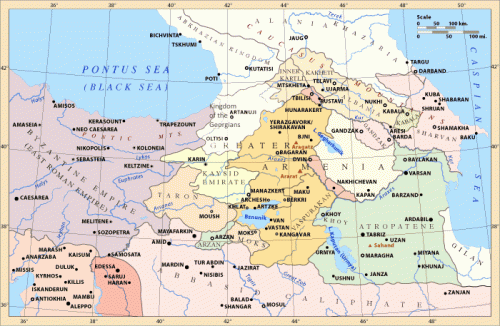

Even in the days of Unicode, typing polytonic Greek is a bother, and transliterating creates issues with different systems in different countries. So I have trouble blaming people for giving texts a standard name in a neutral language which used the same script as their typewriters and printing presses.
Have you ever been able to get a hold of that American dissertation by Witta on Byzantine ethnography? It does not seem to have ever been digitalized, and the early middle ages is so far from my specialty that while I think Maurice is nifty, I have never gone to the trouble of tracking it down.
Yes, I couldn’t replicate the Greek of the edition of the DAI in my handout even with all the blessings of Unicode, not quite. I don’t know the dissertation that you mention: do you have a full reference? I’m not sure I’ll ever pursue it, now that I’m not really a Byzantinist any more, but someone else reading this might…
George T. Dennis gives John Wiita, “The Ethnika in Byzantine Military Treatises” (PhD dissertation, University of Minnesota, 1977).
Given the way that these treatises sometimes reuse material which we can document much earlier (sometimes much earlier: I have seen a passage in an Old Babylonian letter which rings a bell with one of Maurice’s maxims) I wish that more ancient historians would look at them.
John Wiita, “The Ethnika in Byzantine Military Treatises” (PhD dissertation, University of Minnesota, 1977), is available via ProQuest Dissertations and Theses Global. Not that I need anything else to read right now, and it is very far from anything I work on. But as you say, Jonathan, someone else reading this might want to know.
If someone really needs this and doesn’t have access to ProQuest, leave a comment chez moi . . . I might be able to arrange something. ;-)
Most kind of you, your ladyship; I have such but others may not, indeed.
Pingback: What We’re Reading: April 23 | JHIBlog
Pingback: Ethnogenesis for every occasion | A Corner of Tenth-Century Europe
Pingback: From the Sources XIII: a Who’s Who of the tenth-century Caucasus | A Corner of Tenth-Century Europe
Pingback: Leeds IMC Report for 2015, part 4 and final | A Corner of Tenth-Century Europe
Pingback: Leeds International Medieval Congress 2016, reflected upon from a distance | A Corner of Tenth-Century Europe